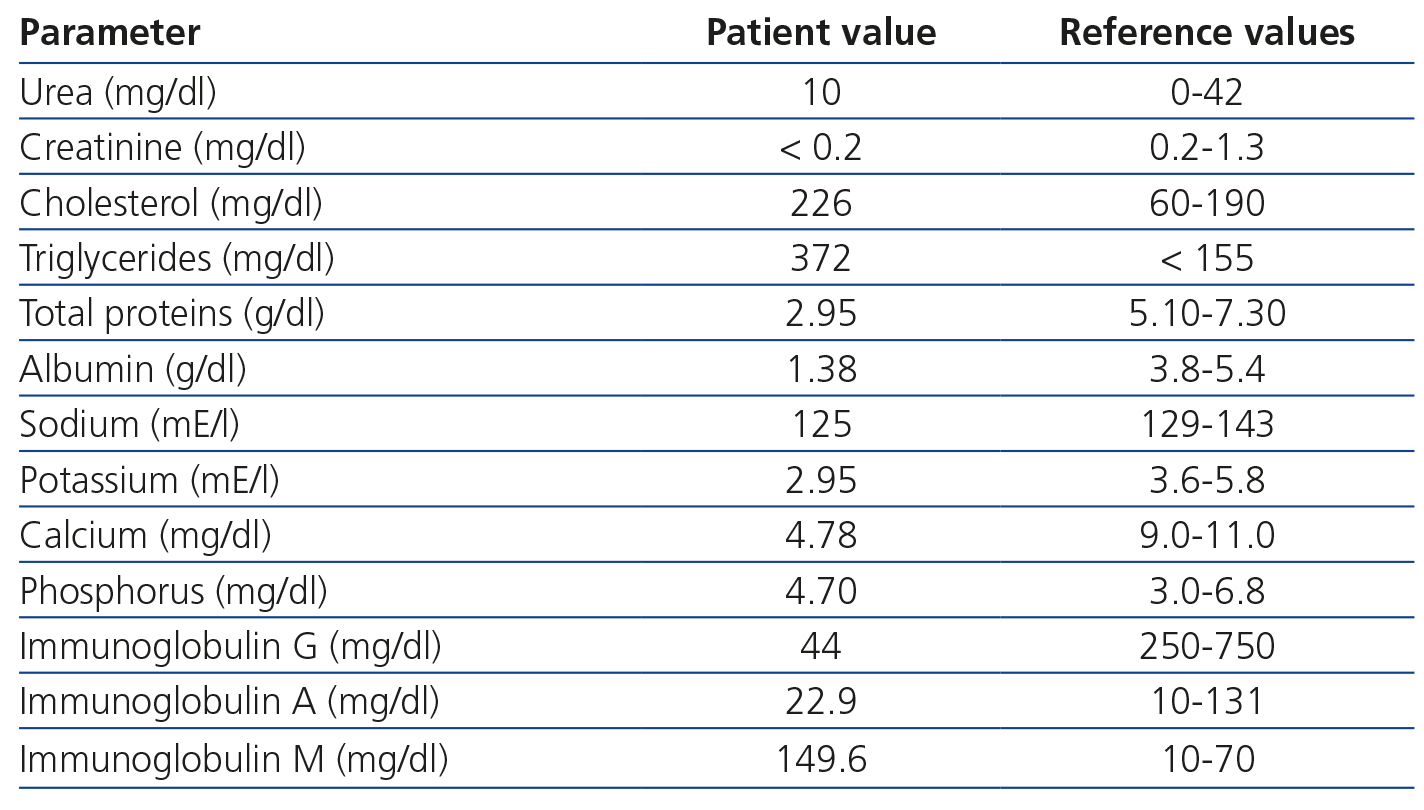To the Editor,
Congenital nephrotic syndrome (CNS) is a serious, rare disease which in most cases has autosomal recessive monogenic inheritance. Several genes are implicated, the most frequent of which are NPHS1, NPHS2, WT1 and LAMB2.1,2 It manifests clinically with massive proteinuria, general oedema, hypoalbuminaemia and hypertriglyceridaemia appearing in the first three months of life.3 Here, we present the first case of a CNS patient with multigenic alteration of three of the four most common genes.
CASE REPORT
Our patient was a one-month-old male from Morocco, who came to the Emergency department after presenting symptoms such as vomiting, rejection of food and abdominal distension which had lasted 4 days. The pregnancy was controlled, with no relevant obstetric or perinatal history. The baby was born full-term with the proper weight for his gestational age. On examination the patient’s general condition was fair, with cutaneous-mucous paleness and general oedema predominant in the lower limbs. A grade IV/VI polyfocal systolic murmur was auscultated. The abdomen was distended, with the presence of the superficial venous system and ascites. Laboratory analyses revealed normocytic-normochromic anaemia, leukocytosis with a normal formula, creatinine below 0.2mg/dl and 10mg/dl urea, high cholesterol and triglycerides, and reduced total proteins and albumin, as well as hyponatraemia, hypopotassaemia and hypocalcaemia (Table 1). The parathyroid hormone was slightly high. The patient’s urine presented nephrotic-range proteinuria with a urine protein:creatinine index of 33.7.
When CNS was suspected, the patient began to undergo intensive diuretic and antiproteinuric therapy, antithrombotic prophylaxis, adjuvant treatment with alfacalcidol, iron, calcium carbonate and levothyroxin, as well as enteral nutrition with hyperprotein, hypercaloric formula. He required treatment with serum albumin and erythropoietin. Moderate pulmonary valve stenosis and atrial septal defect were diagnosed in the cardiology study. The genetic study revealed mutations of the frameshift type for the NPHS1 gene, of the intronic variant type for the NPHS2 gene and of the missense type for the WT1 gene.
At three months of age he was readmitted due to convulsive status epilepticus secondary to severe hypocalcaemia. The high quantities of intravenous calcium which needed treatment via peripheral venous access caused a third-degree burn which required a cutaneous graft to be placed.
Intensive care was required on two occasions, at 4 and 6 months of age, for sepsis secondary to Staphylococcus hominis and Enterococcus faecalis respectively, which were resolved with empirical antibiotic treatment and then according to the results of the antibiogram.
Finally, the patient died at 8 months of age due to bilateral pneumonia linked to pneumothorax with decompensation of the underlying pathology which caused refractory hypoxaemia.
DISCUSSION
CNS may be suspected in the prenatal period due to high levels of alphaphetoprotein, maintaining normal figures for cholinesterase from the 15th week of gestation in amniotic fluid and maternal blood.2,4 At birth the link between premature birth and a large placenta can provide guidance,5 factors which were not present in our patient.
The most frequent cause of this condition is the NPHS1 gene mutation, with autosomal recessive inheritance, responsible for encoding nephrin.2,5,6 This alteration is particularly common in Finland, therefore it has been referred to as CNS of the Finnish type. The NPHS2 gene encodes the protein podocin and is the most common cause of cortico-resistance in childhood.7 The WT1 gene plays a crucial role in the embryonic development of the kidney and the genitals and has been linked to the presence of syndromes such as WAGR, Denys-Drash and Frasier.1,8 It is considered a monogenic condition and no cases have been described in the literature of more than two genes being implicated, therefore the clinical-pathological importance of the finding we have made in this case is not known.
The method of choice for its diagnosis is genetic analysis, although first secondary causes have to be discarded, such as congenital infections, autoimmune diseases or exposure to toxins during pregnancy.9 Knowing this can be useful in the patient’s treatment, prognosis and monitoring, and is key to offering genetic counselling to the family.10 Renal biopsy does not reveal the causes of CNS, as histological findings can occur in various conditions.2 CNS is not normally linked to heart malformations, with the exception of a high frequency of ventricular hypertrophy.11 Our patient presented pulmonary valve stenosis and atrial septal defect, defects scarcely written about in the literature.
The most frequent complications are bacterial infections, especially gram-negative microorganisms.2 Our patient presented two septic infections due to gram-positive bacteria, findings that are less frequent but nonetheless described in other publications.2
The number of hospitalizations in these patients continues to be very high because it is difficult to treat and leads to complications, which reduces the patient’s quality of life.12 It is possible that multigenic involvement might entail greater clinical severity, but as there are no findings similar to ours in the literature we cannot confirm these speculations. The aim of treatment is to control the oedema, prevent and treat complications, and provide adequate nutrition to maximize growth and delay replacement therapy, although, in the majority of cases, kidney transplantation is the only curative method of treatment.3,5,6
In conclusion, CNS is a rare, severe pathology that is difficult to treat, the causes of which can include various genes, which may have important implications on clinical severity and associated complications.
Conflicts of interest
The authors declare that they have no conflicts of interest related to the contents of this article.
Table 1. Analytical parameters upon admission.







